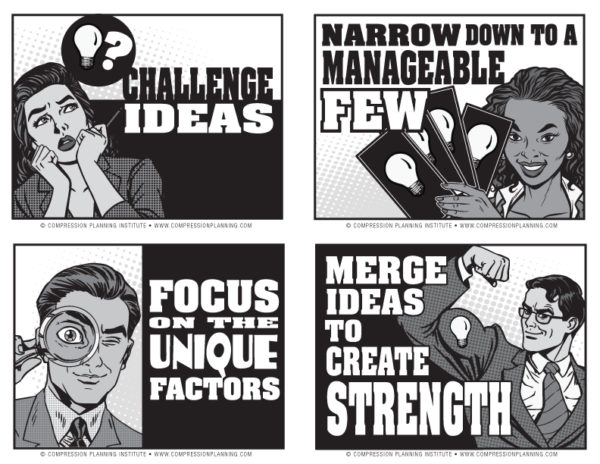Guidelines/Norms/Expectations.
I’ve updated all eight Guideline Cards we use in every session and you can download them here. The content is still the same, but the look and feel are updated.
Below are the four you use during the Explore Phase in a Compression Planning session.
 I’m including my “script” – how I introduce them to groups when I am leading a Compression Planning Session.
I’m including my “script” – how I introduce them to groups when I am leading a Compression Planning Session.
- Suspend Judgment – I tell participants that when they are sharing, they are not making decisions at this point in time. Everyone needs to know they have the freedom to think differently from others around the table. There will be a time to make decisions about what you commit your time, talent and resources to…but it is not when you are addressing the Header questions in front of you. I do not say “there are no bad ideas” because I honestly think there will be…and they will be important to helping unleash what is a keeper and worth pursuing.
- No Speeches – Share your idea. We don’t need to know the history and you don’t have to make a sales pitch for it. 30-45 seconds is usually a good amount of time per idea. I usually ask if anyone around the table feels they excel in this area and someone always raises their hand. I ask them to help “police” the speeches.
- Be Fully Present – I tell the group this is an important topic we are working on. You have all been asked to participate for a reason. For us to make significant progress, we must work on this together. Can we all agree that now is not the time to be checking cell phones/email? If an emergency comes up, absolutely deal with it. But our time together is limited and we thus we need everyone to Be Fully Present.
- Churn Kernels to Rich Ideas – Our time together will be different than many meetings where you do traditional brainstorming. We’ll be spending a little more time developing each idea for specifics as we go. We’re looking for rich, actionable, assignable ideas. It should mean the same thing to everyone sitting around this table and should not be open to interpretation. I may ask you to “say more” about an idea if I feel it is “the kernel” of something that has the potential to be stronger, actionable and assignable.
Post the guidelines and give an intro to each one. The above is my “script” for when I’m working with groups. I say the same thing every time as I know it works and I’m comfortable with it.
After the idea generation phase of your Compression Planning session, you switch gears. You need to start making decisions and the four Guidelines for the Focus Phase are:
- Challenge Ideas – Look at ideas and make sure they deliver your Overall Purpose and Purpose of this Session. It may be a great idea but if it isn’t in alignment with your purposes, it may be something you pursue at a different point in time. Challenge ideas for a fit – not whether they are good or bad.
- Narrow Down to a Manageable Few – I have yet to run across the person who doesn’t have too much on their plate. Groups tend to want to take on too much. We need to determine what we truly need to pursue – what we will commit our limited time, talent and resources to pursuing. Be ready to push your groups to commit to less as things have a greater chance of getting done!
- Focus on the Unique Factors – Given the timing of where you are, with the resources you have at your disposal, what are those ideas/cards that can truly deliver your Purposes? Similar to Challenge…but with the permission to look at ideas that may have a unique twist – those ideas that have “never been done before” for whatever reason.
- Merge Ideas to Create Strength – There may be an opportunity to merge some cards. We won’t be overmerging ideas and identifying themes. Groups have a tendency to see a theme and then want to bunch all of the cards together. I always say “If you can do one card without doing the other, then they need to compete against each other. If they naturally go together to make ONE stronger idea, then we will merge them.” Also, merge after dotting. You can spend a LOT of time merging before dotting and everyone will want to put different cards together. If an idea is worth pursuing, you’ll have the opportunity to discuss it.
These Focus Guidelines are used during the Focus Phase – i.e. the Dotting Phase. Not the VOTING Phase, but dotting. It starts discussion towards making decisions. The dots in and of themselves are NOT the decisions!
Hope you enjoy the new Guideline Cards as much as I do! Feel free to comment below with any questions regarding Guidelines/Norms with your groups.


No comments yet.